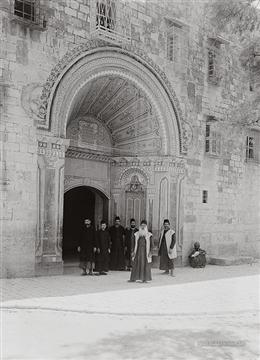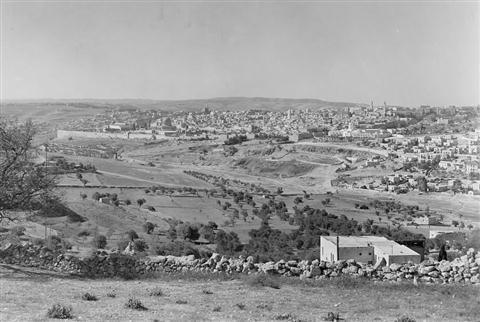

Armenian Jerusalem

Armenians have been living in Jerusalem for over 2,000 years. The
Armenian connection to Jerusalem predates the Christian era. The first
Armenians to set foot in the Holy Land, pagan idol-worshippers, would have
been conscripts or mercenaries marching with the conquering armies of
Tigranes II. Historically, it is uncertain whether Tigranes did actually
conquer Jerusalem, but there is no doubt that he had overrun Judea.
Some of his soldiers settled in the region, others moved north towards greener the pastures of the fertile crescent (that would have included Syria and Lebanon), and a number settled in the land of Canaan. When the Armenian nation became the first in the world to accept Christianity as its state religion, my ancestors lost no time making the pilgrimage to Jerusalem. They came on the back of camels and donkeys, braving the long travails of danger and hardship: but their first sight of the golden city with its towering walls, reinforced their faith. In one caravan alone, there were more than 700 camels. Halfway between Jericho and Jerusalem, the pilgrims paused to set up what would later become the foundation for the first Christian monastery in the Holy Land. The site, now known by its Arabic name of Khan El Ahmar (the red "khan", or caravanserai), also features in the bible as the place where the the Good Samarian came to the succor of the injured traveler. A typical feature of those early monasteries was the creation of a floor mosaic with the emphasis on depicting local flora and fauna. But the 6th Century "medallion" uncovered recently (in 1991), bore only a script in the Classical Armenian of the day, laid out in capital letters. Historians estimate that the Armenians had built hundreds of monasteries and churches along the width and breadth of the Holy Land, but today only a handful survive, among them the magnificent cathedral of St James, situated within the convent that is the seat of the Armenian Patriarchate. Armenians are a nation of survivors. Pulitzer Prize winner William Saroyan calls us a small tribe of unimportant people that no power on earth can destroy. "See if you can do it," he says. Even if you "send them into the desert without bread or water, burn their homes and churches," they will laugh, sing and pray again. And whenever two of them meet anywhere in the world, "see if they will not create a New Armenia." Of course, he got it wrong when he assumed that our structures have crumbled, our battles fought and lost, our literature unread and our music unheard. Had he forgotten William Saroyan, Charles Aznavour, Hagop Oshagan, Roupen Mamoulian and Ohan Durian? There were no Kim Kardashians, Cher Sarkissians or Joe [Hokedoonian] Hockeys then, true. Neither had Armenia broken free of the former Soviet Union and reclaimed its independence. The Persians tried to force Christian Armenia into fire-worship and failed. The Turks tried to exterminate the flower of Armenian intellectual, artistic and religious culture, and failed. Perhaps, in time, the Armenians are destined to succumb to the insipid wiles of assimilation where armies and armaments made no headway. It won't happen in Jerusalem. Despite the relentless encroachments of attrition: at one stage, there were thousands of Armenians living in and around the Convent of St James, their numbers touching 25,000. Today, that has shriveled to a fraction, but although the political future remains uncertain as Israelis and Palestinians wrangle over the status of the city they have made their home, Armenians know that the imprint they have made on Jerusalem, is indelible. Armenians reached the Holy Land around 100 BCE, when Tigranes the Great ruled an empire extending from the Caspian Sea to the shores of the Mediterranean. The first time the word "Armenia" is mentioned in a historical context is in an inscription attributed to King Darius. Armenians arrived in the wake of conquering armies, as traders, artisans, legionnaires and administrators. But it was Christianity that put the final stamp on the perpetual Armenian presence in Jerusalem. Diaspora Armenians are thus descended primarily from ancestors who lived in historic Armenia. Many still have relatives in the disparate towns and villages of the parts of Armenia now ruled by Turkey, although their roots may have disappeared from the pages of history following frequent family name changes, necessitated by political exigencies. Apkar, for example, has been changed to Ali, Misak into Murad, or even Mohammed. And the unique Armenian patronymic "ian" has been obliterated from family names. Armenians have survived in the past by challenging empires and by scuttling all attempts at assimilation. They have never taken kindly to these. However, they adapt easily to changing circumstances because they are pliable and pragmatic. Social historians point out that being a mountain race, Armenians have always been a fighting people, fiercely jealous of their independence. But that has not made them ossified relics. On the contrary, the Armenians have merged with the stream, while retaining their own uniqueness, quite adroitly. In Jerusalem, the only threat to their ethnic purity would be intermarriage with "odar"s (non-Armenians), mainly other Christians. This is a people that believes in the eternality of their race, symbolized by their emblem - the soaring twin peaks of Mount Ararat, traditional site of Noah's stranded ark. The goldsmiths, jewelers, photographers, pharmacists, teachers and potters who pound the ancient cobblestones of the Old City of Jerusalem - which has become a fount of spirituality second only to the Cathedral of Etchmiadzin in Yerevan, capital of Armenia - are living proof of Armenian durability Jerusalem's Armenian community is concentrated in the complex of St. James and the encircling Armenian Quarter. In its heyday, the compound was home for nearly 25,000 people, sometimes crammed ten to a room. That number has been shrinking inexorably over the years, the first significant depletion occurring in the 1948 exodus (some would call it repatriation) to the homeland in Armenia. Today, barely a few hundred still hold the fort in the Old City, with another eight to nine hundred scattered throughout Israel, mainly in Jaffa and Haifa, and the West Bank (Bethlehem, Ramallah and Gaza). A far larger number live in the neighboring Arab countries where they had found a secure and generous haven as they fled from the Turkish massacres. The Armenian Patriarchate has won semi-diplomatic status as one of the three guardians (the others are the Greek Patriarchate and the Latin Custodia) of the Holy Places [which includes the church of the Holy Sepulchre, the Church of Ascension, the Tomb of the Virgin at Gathsemane, all in Jerusalem, and the Church of Nativity in Bethlehem]. Without this, the Armenians here would be no more than simple landholders. The Armenian Patriarchate is a city within a city, running manifold educational, cultural and religious programs, subsisting on revenues mainly derived from the rents it collects on its properties in West Jerusalem and other parts of the land, both in Israel and the West Bank. The Armenians of the Holy Land generally fall into four different groupings. The "kaghakatsis" (native residents) live in the Armenian Quarter where they established roots centuries ago. They have a cultural club of their own, the JABU (Jerusalem Armenian Benevolent Union). At one time the JABU was the guiding spirit of the Armenian community, but it has become a mere shadow of its former self, its members scattered all over the world. The club premises have virtually been abandoned; the beautiful, expansive hall where banquets were once held and the grand stage where Julius Caesar used to strut have been claimed by ghosts. Within the St. James convent, the "Vanketsis" (convent dwellers) are divided into two distinct groupings with differing "political" leanings, the shades blurred in the wake of Armenia's newly gained independence: the Hoyetchmen, the bigger group, has been more active and more influential. It pines for a return to the homeland, even under Soviet rule, while the Homentmen wanted a free, independent Armenia. The Homentmen cultivates the "Hai Tad" (Armenian cause) organization, set up to perpetuate the memory of the Armenian genocide and to spur Turkey to admit guilt and responsibility for the estimated 1,500,000 men, women and children massacred in 1915. The two run youth clubs at a stone's throw from each other. In years gone by, there had been no love lost between the two, but global developments and realities have inevitably dulled the edge of irreconcilable differences and they have grown closer to each other. The fourth Armenian grouping revolves around the Catholic church. They have their own church and were traditionally considered outcasts by mainstream Armenians who pride themselves on being sons of the Lousavoritch, Gregory the Illuminator, patron of the Armenian Orthodox Church. The Armenian Patriarchate of Jerusalem has titular ownership of all property in the Armenian compound - but no one pays it rent although the kaghakatsi are liable to municipal taxes since their residences fall outside the boundaries of the Convent which, as a religious institution, is exempt from land duties. Some of the houses in the Armenian Quarter have been inhabited by the same family for generations. A cursory glance at the architecture yields telltale evidence of the slipshod art of Ottoman masonry. Walls are sometimes three feet thick. Foundations are pure earth, pressed tight, with a scattering of rocks. Sunlight and ventilation are unheard of luxuries. The plaster cakes continually, as the walls shed their whitewash under the ravages of humidity. The houses may be nothing more than dank dungeons, in some cases, but for hundreds of years, Armenians have been born and bred here. Perhaps the fact that the houses are blessed twice every year (at Christmas and Easter) by the parish priest, helps to make them habitable. Although the older generations are too deeply rooted in their way of life to consider leaving, the young are inclined to think of their sojourn in Jerusalem as merely temporary. Many believe that this is merely a way station, that their future, or that of their offspring, lies in America, Canada, Australia, or perhaps Armenia. There was a time in the Old City when family ties were unshakable - and no one ever heard of a son or daughter leaving home, whether when he or she turned eighteen, or at all. This did not imply a total embargo or moratorium on the movements of people: rather the reluctance to abandon familiar and familial grounds for the strange unknown, perhaps replete with risks and uncertainty. The only exception was the odd "business" travel - my own father left home as a late teen, accompanied by an uncle, to try his luck in Uruguay, of all places. They stayed there fore 10 years: the money they made peddling clothes door to door enabled my father to set up shop as a leading wool merchant, just outside Jaffa Gate. But things change, and ties begin to loosen. Almost every parent in Jerusalem will at some time face the inevitable prospect of seeing a son or daughter leave the family roost, temporarily or permanently. But they are bolstered and consoled by the opportunities the children will have to better their prospects. And with Skype and Facebook, and God knows what other hi-tech communication delights are yet in store for us, the distances and time lapses are shortened.





























